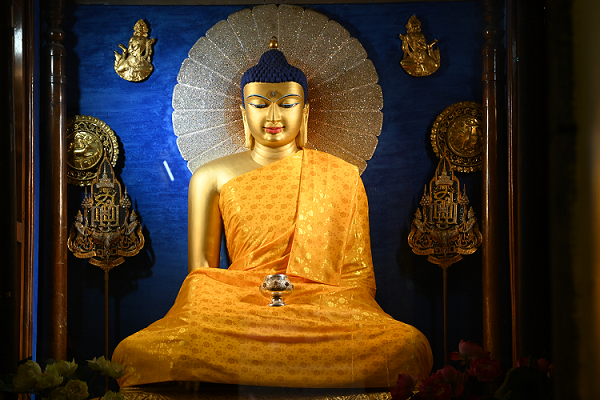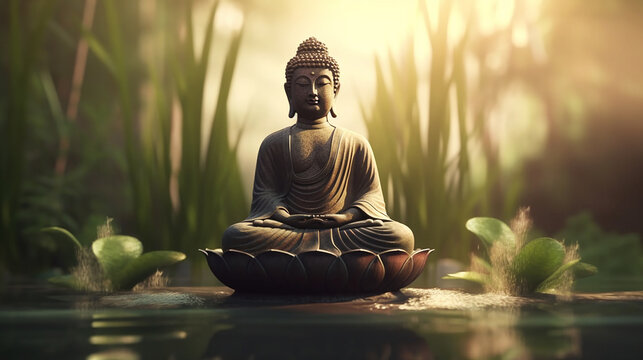Buddhism, one of the world’s major religions, is not just a belief system but a way of life that offers profound insights into the nature of existence and the human mind. Originating from the teachings of Siddhartha Gautama, known as the Buddha, in ancient India around the 6th century BCE, Buddhism has since spread across the globe, influencing countless individuals with its wisdom and practices. This article explores the core principles of Buddhism, its historical development, its impact on society and culture, and its relevance in the modern world.
The Life of the Buddha
To understand Buddhism, we must first understand the life of its founder, Siddhartha Gautama. Born into a royal family in present-day Nepal, Siddhartha lived a life of luxury and privilege. However, he was deeply troubled by the suffering and impermanence he saw in the world around him. At the age of 29, Siddhartha renounced his royal lifestyle and set out on a quest for truth and enlightenment.


After years of meditation and spiritual practice, Siddhartha finally attained enlightenment at the age of 35 while meditating under a Bodhi tree in Bodh Gaya, India. He became known as the Buddha, or the “Enlightened One,” and spent the rest of his life teaching others about the path to liberation from suffering.
The Four Noble Truths
The Four Noble Truths are the foundational teachings of Buddhism, articulated by the Buddha in his first sermon after attaining enlightenment. They form the core of Buddhist philosophy and provide a framework for understanding the nature of suffering and the path to liberation.
The Truth of Suffering (Dukkha):
- Dukkha is a Pali term often translated as “suffering,” “unsatisfactoriness,” or “discontent.” It refers to the inherent dissatisfaction and discomfort that is part of the human condition.
- The Buddha taught that life is filled with various forms of suffering, including physical pain, emotional distress, and existential angst. Even moments of pleasure are temporary and ultimately unsatisfying, leading to a sense of longing or dissatisfaction.
- Recognizing the truth of suffering is the first step on the path to liberation, as it motivates individuals to seek a deeper understanding of the causes of suffering and how to overcome it.
The Truth of the Cause of Suffering (Samudaya):
- The second Noble Truth identifies the cause of suffering as craving (tanha) and attachment to transient phenomena. Craving arises from our desire for pleasure, existence, or non-existence, and leads to clinging and attachment, which in turn causes suffering.
- Craving can take many forms, such as the desire for sensory pleasures, the craving for existence and success, or the aversion to unpleasant experiences. These desires are insatiable and ultimately lead to dissatisfaction and suffering.
- By understanding the root causes of suffering as craving and attachment, individuals can begin to address these underlying causes and free themselves from the cycle of suffering.
The Truth of the Cessation of Suffering (Nirodha):
- The third Noble Truth teaches that there is a way to end suffering by overcoming craving and attachment. This state of liberation from suffering is known as Nirvana.
- Nirvana is not merely the absence of suffering but a state of profound peace, freedom, and contentment that is beyond worldly pleasures and pains. It is the ultimate goal of Buddhist practice, representing the end of the cycle of birth, death, and rebirth (Samsara).
- The realization of Nirvana is achieved through the practice of the Eightfold Path, which leads to the cessation of craving and the attainment of enlightenment.
The Truth of the Path to the Cessation of Suffering (Magga):
- The fourth Noble Truth outlines the Eightfold Path, which is the path to the cessation of suffering and the attainment of Nirvana. The Eightfold Path is divided into three categories: wisdom (right view, right intention), ethical conduct (right speech, right action, right livelihood), and mental discipline (right effort, right mindfulness, right concentration).
- By cultivating wisdom, ethical conduct, and mental discipline, individuals can gradually overcome craving and attachment, purify the mind, and attain enlightenment.
- The Eightfold Path is not a linear progression but a holistic practice that encompasses all aspects of life. It is a lifelong journey of self-discovery, transformation, and awakening.
The Eight Fold path
The Eightfold Path is a central teaching in Buddhism, representing the path to the cessation of suffering (Nirvana) and the attainment of enlightenment. It is part of the Fourth Noble Truth, which outlines the path to liberation from suffering. The Eightfold Path is divided into three categories: wisdom, ethical conduct, and mental discipline.
Right View (Samma Ditthi):
- Right View is the first step on the Eightfold Path and involves understanding the Four Noble Truths and the nature of reality. It is the foundation of the path, as it guides all other aspects of practice.
- Right View involves seeing things as they truly are, without delusion or distortion. It includes understanding the impermanence of all things, the nature of suffering, and the interconnectedness of all beings.
Right Intention (Samma Sankappa):
- Right Intention involves cultivating wholesome intentions and attitudes. It includes renouncing harmful desires, cultivating compassion and loving-kindness, and developing a mindset of non-attachment.
- Right Intention is about aligning one’s thoughts and aspirations with the path to enlightenment, focusing on the well-being of oneself and others.
Right Speech (Samma Vaca):
- Right Speech involves speaking truthfully, kindly, and beneficially. It includes refraining from lying, gossiping, harsh speech, and divisive speech.
- Right Speech is about using words to promote harmony, understanding, and compassion, rather than causing harm or discord.
Right Action (Samma Kammanta):
- Right Action involves acting ethically and responsibly. It includes refraining from killing, stealing, and sexual misconduct.
- Right Action is about living a life that is aligned with the principles of compassion, non-violence, and respect for all beings.
Right Livelihood (Samma Ajiva):
- Right Livelihood involves earning a living in a way that is ethical and does not harm others. It includes refraining from occupations that involve killing, stealing, or harming others.
- Right Livelihood is about finding a vocation that is aligned with one’s values and contributes to the well-being of oneself and others.
Right Effort (Samma Vayama):
- Right Effort involves making a conscious effort to cultivate positive qualities and overcome negative ones. It includes cultivating mindfulness, concentration, and perseverance in one’s practice.
- Right Effort is about being diligent and committed to the path of awakening, even in the face of challenges and distractions.
Right Mindfulness (Samma Sati):
- Right Mindfulness involves being fully present and aware of one’s thoughts, feelings, sensations, and surroundings. It includes cultivating mindfulness in all activities, both formal meditation practice and daily life.
- Right Mindfulness is about developing a clear and focused awareness that allows one to see things as they truly are, without being caught up in judgment or reactivity.
Right Concentration (Samma Samadhi):
- Right Concentration involves developing deep states of concentration through meditation. It includes cultivating single-pointed concentration and mental absorption.
- Right Concentration is about training the mind to be focused, calm, and undistracted, which leads to greater clarity, insight, and wisdom.
The Three Marks of Existence
The Three Marks of Existence, also known as the Three Universal Truths, are fundamental concepts in Buddhism that describe the nature of reality and the human condition. These marks are impermanence (Anicca), suffering (Dukkha), and non-self (Anatta). Understanding these marks is crucial for developing insight into the nature of existence and for progressing on the path to enlightenment.
Impermanence (Anicca):
- Impermanence refers to the universal truth that all conditioned phenomena are in a constant state of flux and change. This includes all physical and mental phenomena, from the changing seasons to the thoughts and emotions in our minds.
- The concept of impermanence teaches us to let go of attachments to things that are transient and impermanent, leading to greater acceptance of change and a deeper understanding of the nature of reality.
- The realization of impermanence is a key insight in Buddhism, as it helps us to see that clinging to things that are impermanent leads to suffering while letting go of attachments brings freedom and peace.
Suffering (Dukkha):
- Suffering, or Dukkha, is a central concept in Buddhism that refers to the unsatisfactory nature of existence. It encompasses physical and emotional pain, as well as the general dissatisfaction and unease that pervades human life.
- The Buddha taught that suffering arises from craving (Tanha) and attachment to transient things. By understanding the causes of suffering, we can work to overcome them and find liberation from suffering.
- The recognition of suffering is not meant to be pessimistic but rather to encourage us to seek a deeper understanding of the nature of reality and to cultivate compassion and wisdom.
Non-Self (Anatta):
- Non-Self, or Anatta, is the teaching that there is no permanent, unchanging self or soul. Instead, our sense of self is a constantly changing process that is influenced by external and internal conditions. The concept of non-self challenges the notion of a fixed and independent self, leading to a more flexible and open-minded understanding of identity. It encourages us to let go of the illusion of a separate self and to see ourselves as interconnected with all beings.
- The realization of non-self is liberating, as it frees us from the burden of self-centeredness and allows us to cultivate a more compassionate and inclusive attitude toward others.
The Three Jewels: Buddha, Dharma, Sangha
The Three Jewels, also known as the Triple Gem, are central to Buddhism and represent the core elements of the Buddhist path. They are the Buddha, the Dharma, and the Sangha, and taking refuge in them is a fundamental practice for Buddhists.
The Buddha:
- The first Jewel is the Buddha, Siddhartha Gautama, who lived in India over 2,500 years ago and founded Buddhism. He is revered as the Awakened One who attained enlightenment and taught the path to liberation from suffering.
- Taking refuge in the Buddha involves placing trust in his teachings and example, and aspiring to follow his path to enlightenment. The Buddha serves as a guide and inspiration for practitioners on the spiritual journey.
The Dharma:
- The second Jewel is the Dharma, which refers to the teachings of the Buddha. The Dharma encompasses the entire body of Buddhist teachings, including the Four Noble Truths, the Eightfold Path, and the various sutras and scriptures.
- Taking refuge in the Dharma involves studying, practicing, and embodying the teachings to gain insight into the nature of reality and to transform one’s mind and heart. The Dharma is seen as a guide to living a life of wisdom, compassion, and virtue.
The Sangha:
- The third Jewel is the Sangha, which refers to the community of Buddhist practitioners. This includes ordained monks and nuns, as well as lay practitioners who support and uphold the teachings.
- Taking refuge in the Sangha involves seeking the guidance and support of fellow practitioners on the spiritual path. The Sangha provides a community where individuals can learn from each other, practice together, and receive encouragement and inspiration.
The Three Jewels are not only objects of devotion but also represent the principles and values that Buddhists aspire to embody in their lives. By taking refuge in the Buddha, the Dharma, and the Sangha, practitioners seek guidance, inspiration, and support on the path to enlightenment.
The Historical Development of Buddhism
After the Buddha’s death, his teachings were orally transmitted by his disciples and later written down in various scriptures and sutras. Over time, Buddhism spread throughout Asia and evolved into different schools and traditions, each with its own interpretations of the Buddha’s teachings and practices.
Theravada Buddhism, the oldest surviving school, is prevalent in Southeast Asia and emphasizes the original teachings of the Buddha as found in the Pali Canon. Mahayana Buddhism, which emerged later, is practiced in East Asia and includes schools such as Zen, Pure Land, and Tibetan Buddhism. Mahayana Buddhism emphasizes the bodhisattva ideal, the aspiration to attain enlightenment for the benefit of all beings.
Vajrayana Buddhism, also known as Tantric Buddhism, is a form of Buddhism that developed in India and later spread to Tibet and Mongolia. Vajrayana Buddhism emphasizes the use of rituals, visualizations, and meditative practices to attain enlightenment in one lifetime.
The Spread of Buddhism
Buddhism spread from India to other parts of Asia, including Sri Lanka, China, Korea, Japan, and Southeast Asia, through trade, missionary activity, and royal patronage. Along the way, Buddhism adapted to local cultures and customs, giving rise to diverse forms of practice and belief.

In modern times, Buddhism has spread to the West and other parts of the world, where it has gained popularity for its emphasis on mindfulness, compassion, and the quest for inner peace. Today, there are an estimated 500 million Buddhists worldwide, making Buddhism one of the world’s major religions.
Buddhism in the Modern World
In the modern world, Buddhism continues to be a source of inspiration and guidance for millions of people seeking meaning, purpose, and spiritual fulfillment. Its teachings on mindfulness, compassion, and wisdom offer a profound antidote to the stresses and challenges of contemporary life.

Buddhism has also influenced Western culture and thought, particularly in the fields of psychology, philosophy, and mindfulness. Practices such as meditation and mindfulness have been widely adopted in secular contexts, leading to a growing interest in the intersection of Buddhist teachings and modern psychology.
Conclusion
Buddhism is a rich and diverse tradition that offers profound insights into the nature of reality, the human mind, and the path to liberation from suffering. Its teachings on the Four Noble Truths, the Eightfold Path, and the Three Marks of Existence provide a comprehensive framework for understanding the nature of existence and the causes of suffering.


Through its emphasis on mindfulness, compassion, and wisdom, Buddhism offers a path to inner peace, wisdom, and enlightenment that is as relevant today as it was 2,500 years ago. As Buddhism continues to evolve and adapt to the modern world, its timeless teachings continue to inspire and transform the lives of millions of people around the world.
FAQ
What are the four Noble Truths in Buddhism?
The Four Noble Truths are the foundational teachings of Buddhism, articulated by the Buddha in his first sermon after attaining enlightenment. They form the core of Buddhist philosophy and provide a framework for understanding the nature of suffering and the path to liberation.
What are the three Jewels in Buddhism?
The Three Jewels, also known as the Triple Gem, are central to Buddhism and represent the core elements of the Buddhist path. They are the Buddha, the Dharma, and the Sangha, and taking refuge in them is a fundamental practice for Buddhists.
What are the Eightfold Paths in Buddhism?
The Eightfold Path is a central teaching in Buddhism, representing the path to the cessation of suffering (Nirvana) and the attainment of enlightenment. It is part of the Fourth Noble Truth, which outlines the path to liberation from suffering. The Eightfold Path is divided into three categories: wisdom, ethical conduct, and mental discipline.
FOLLOW US ON





Pingback: Je Tsongkhapa: A Biography and His Profound Contributions to Tibetan Buddhism - buddhistpsy.com
Pingback: Nagarjuna: Life, Philosophy and Legacy - buddhistpsy.com
Pingback: Paro Taktsang: The Iconic Himalayan Monastery - buddhistpsy.com
Pingback: Karma: The Law of Cause and Effect - buddhistpsy.com
Pingback: What Is Buddhist Psychology? - buddhistpsy.com
Pingback: Anger According To Buddhist Psychology - buddhistpsy.com
Pingback: Analytical Meditation - buddhistpsy.com
Pingback: Self-Compassion According To Buddhist Psychology - buddhistpsy.com
Pingback: Is Buddhism A Part Of Hinduism? - buddhistpsy.com
Pingback: Om Mani Padme Hum - buddhistpsy.com
Pingback: Anger- How it affects us? - buddhistpsy.com
Pingback: Impact of Buddhist Mindfulness Practice on Psychological Well-Being - buddhistpsy.com
Pingback: Santaraksita: The Greatest Contributor to Tibetan Buddhism - buddhistpsy.com
Pingback: Ananda, the Disciple of Buddha - buddhistpsy.com
Pingback: Buddhist Mindfulness - buddhistpsy.com
Pingback: What is Buddhism: 10 Minute Introduction - buddhistpsy.com
Pingback: The Origin of Suffering and the Path to Liberation: Mantra of Dependent origination - buddhistpsy.com
I know this if off topic but I’m looking into starting my own weblog and was curious what all is required to get setup? I’m assuming having a blog like yours would cost a pretty penny? I’m not very internet smart so I’m not 100 positive. Any suggestions or advice would be greatly appreciated. Thanks
Hi there! I could have sworn I’ve been to this site before but after checking through some of the post I realized it’s new to me. Anyways, I’m definitely happy I found it and I’ll be book-marking and checking back often!
thanks for your kind feedback
I am extremely impressed together with your writing abilities and also with the layout for your weblog. Is that this a paid topic or did you customize it yourself? Either way stay up the excellent high quality writing, it?s rare to look a great weblog like this one these days..
thanks for your kind feedback
WONDERFUL Post.thanks for share..extra wait .. ?
sure thanks
As I web-site possessor I believe the content material here is rattling great , appreciate it for your efforts. You should keep it up forever! Good Luck.
Have you ever thought about adding a little bit more than just your articles? I mean, what you say is valuable and everything. Nevertheless imagine if you added some great graphics or video clips to give your posts more, “pop”! Your content is excellent but with pics and videos, this website could certainly be one of the most beneficial in its niche. Amazing blog!
Thanks for your blog post. A few things i would like to make contributions about is that computer system memory ought to be purchased if your computer still can’t cope with anything you do by using it. One can put in two random access memory boards of 1GB each, in particular, but not one of 1GB and one having 2GB. One should look for the car maker’s documentation for own PC to ensure what type of memory is required.
I would like to thnkx for the efforts you’ve put in writing this site. I’m hoping the same high-grade blog post from you in the upcoming as well. In fact your creative writing abilities has encouraged me to get my own site now. Really the blogging is spreading its wings rapidly. Your write up is a great example of it.
Hey! This is my first comment here so I just wanted to give a quick shout out and tell you I genuinely enjoy reading your blog posts. Can you recommend any other blogs/websites/forums that go over the same topics? Many thanks!
You can definitely see your skills within the work you write. The arena hopes for more passionate writers such as you who are not afraid to say how they believe. All the time follow your heart.
Coming from my investigation, shopping for gadgets online can for sure be expensive, yet there are some principles that you can use to obtain the best products. There are usually ways to discover discount bargains that could help to make one to hold the best electronics products at the cheapest prices. Interesting blog post.
Hello there! I could have sworn I’ve been to this website before but after reading through some of the post I realized it’s new to me. Anyways, I’m definitely happy I found it and I’ll be bookmarking and checking back frequently!
Thanks for the posting. My spouse and i have usually observed that the majority of people are desirous to lose weight since they wish to appear slim in addition to looking attractive. On the other hand, they do not constantly realize that there are additional benefits for you to losing weight additionally. Doctors claim that overweight people come across a variety of ailments that can be perfectely attributed to their excess weight. The good thing is that people who sadly are overweight in addition to suffering from a variety of diseases are able to reduce the severity of the illnesses simply by losing weight. It’s possible to see a gradual but notable improvement with health whenever even a slight amount of weight-loss is attained.
Its such as you read my thoughts! You appear to know so much about this, such as you wrote the e book in it or something. I believe that you can do with a few percent to pressure the message home a little bit, but instead of that, this is fantastic blog. A fantastic read. I will certainly be back.
The following time I read a blog, I hope that it doesnt disappoint me as a lot as this one. I imply, I know it was my choice to learn, however I really thought youd have one thing attention-grabbing to say. All I hear is a bunch of whining about something that you would repair when you werent too busy in search of attention.
Usually I don’t learn article on blogs, but I would like to say that this write-up very forced me to take a look at and do it! Your writing taste has been amazed me. Thanks, very great article.
Thanks for revealing your ideas. I’d also like to say that video games have been actually evolving. Today’s technology and innovations have helped create realistic and enjoyable games. These kind of entertainment games were not really sensible when the concept was first of all being attempted. Just like other areas of technological know-how, video games too have had to advance by means of many many years. This is testimony towards the fast development of video games.
Thanks for the advice on credit repair on your web-site. Things i would tell people will be to give up the mentality that they may buy currently and fork out later. As a society all of us tend to do this for many things. This includes getaways, furniture, as well as items we really want to have. However, you should separate a person’s wants from all the needs. If you are working to raise your credit ranking score you have to make some sacrifices. For example it is possible to shop online to save cash or you can go to second hand outlets instead of high priced department stores to get clothing.
great post, very informative. I wonder why the other specialists of this sector don’t notice this. You must continue your writing. I am confident, you’ve a great readers’ base already!
thanks for your feed 😇
This article is a breath of fresh air! The author’s distinctive perspective and insightful analysis have made this a truly captivating read. I’m appreciative for the effort she has put into producing such an enlightening and mind-stimulating piece. Thank you, author, for providing your wisdom and igniting meaningful discussions through your outstanding writing!
thanks for your feed 😇
I have noticed that credit restoration activity should be conducted with tactics. If not, you are going to find yourself causing harm to your position. In order to succeed in fixing your credit history you have to ensure that from this moment in time you pay your monthly costs promptly before their planned date. It is significant because by certainly not accomplishing this, all other moves that you will choose to adopt to improve your credit position will not be effective. Thanks for giving your ideas.
This will be a excellent site, could you be interested in doing an interview regarding how you developed it? If so e-mail me!
Your house is valueble for me. Thanks!?
You made some respectable points there. I appeared on the internet for the issue and found most people will go along with along with your website.
A person essentially help to make significantly posts I would state. This is the very first time I frequented your website page and to this point? I amazed with the analysis you made to create this actual put up extraordinary. Excellent process!
I used to be suggested this website via my cousin. I’m now not sure whether this post is written by him as nobody else know such targeted about my problem. You are incredible! Thanks!
I have learned result-oriented things from your blog post. Also a thing to I have seen is that typically, FSBO sellers can reject an individual. Remember, they’d prefer not to ever use your expert services. But if you maintain a gradual, professional relationship, offering support and remaining in contact for four to five weeks, you will usually have the ability to win interviews. From there, a house listing follows. Thanks a lot
Thanks for your beneficial post. As time passes, I have come to understand that the symptoms of mesothelioma are caused by the build up connected fluid between the lining of the lung and the torso cavity. The illness may start inside chest place and distribute to other body parts. Other symptoms of pleural mesothelioma include weight reduction, severe inhaling trouble, a fever, difficulty taking in food, and irritation of the neck and face areas. It ought to be noted that some people having the disease never experience any kind of serious indications at all.
thanks for your support and comments
Oh my goodness! a tremendous article dude. Thanks Nonetheless I’m experiencing challenge with ur rss . Don?t know why Unable to subscribe to it. Is there anybody getting equivalent rss downside? Anybody who knows kindly respond. Thnkx
thanks for your support and comments
What an eye-opening and meticulously-researched article! The author’s meticulousness and aptitude to present intricate ideas in a digestible manner is truly commendable. I’m extremely enthralled by the scope of knowledge showcased in this piece. Thank you, author, for offering your knowledge with us. This article has been a true revelation!
thanks for your support and comments
Thanks for the points shared on the blog. Another thing I would like to say is that fat loss is not exactly about going on a dietary fad and trying to get rid of as much weight as you’re able in a couple of weeks. The most effective way to lose weight is by getting it little by little and obeying some basic suggestions which can assist you to make the most from a attempt to drop some weight. You may recognize and already be following some of these tips, yet reinforcing knowledge never affects.
thanks for your support and comments
This is really interesting, You’re a very skilled blogger. I’ve joined your rss feed and look forward to seeking more of your fantastic post. Also, I’ve shared your web site in my social networks!
thanks for your support and comments
Almost all of the things you claim happens to be astonishingly legitimate and that makes me wonder the reason why I hadn’t looked at this with this light before. This piece really did turn the light on for me as far as this specific subject matter goes. But at this time there is 1 point I am not too comfortable with and whilst I make an effort to reconcile that with the central theme of the point, permit me see what the rest of the visitors have to say.Nicely done.
Somebody essentially help to make seriously articles I would state. This is the very first time I frequented your web page and thus far? I surprised with the research you made to make this particular publish amazing. Great job!
hey there and thanks for your information ? I?ve definitely picked up something new from proper here. I did however experience several technical issues the usage of this web site, since I experienced to reload the website a lot of instances prior to I could get it to load correctly. I were wondering in case your web hosting is OK? No longer that I’m complaining, but sluggish loading instances occasions will sometimes affect your placement in google and could harm your high quality ranking if ads and ***********|advertising|advertising|advertising and *********** with Adwords. Anyway I?m adding this RSS to my email and can glance out for much extra of your respective intriguing content. Make sure you update this once more very soon..
Thank you for every other informative website. The place else may just I am getting that type of info written in such a perfect way? I’ve a mission that I am just now running on, and I have been on the glance out for such information.
Nice blog here! Also your web site loads up very fast! What host are you using? Can I get your affiliate link to your host? I wish my web site loaded up as fast as yours lol
Hi there I am so delighted I found your website, I really found you by accident, while I was searching on Digg for something else, Anyways I am here now and would just like to say thank you for a marvelous post and a all round enjoyable blog (I also love the theme/design), I don’t have time to read through it all at the moment but I have saved it and also added in your RSS feeds, so when I have time I will be back to read a lot more, Please do keep up the awesome job.
I believe one of your commercials triggered my web browser to resize, you may well want to put that on your blacklist.
Oh my goodness! an incredible article dude. Thank you Nonetheless I am experiencing situation with ur rss . Don?t know why Unable to subscribe to it. Is there anyone getting similar rss problem? Anybody who is aware of kindly respond. Thnkx
One thing I would like to say is that often car insurance cancellation is a dreadful experience so if you’re doing the suitable things as a driver you will not get one. Lots of people do get the notice that they have been officially dropped by the insurance company and several have to struggle to get added insurance after a cancellation. Cheap auto insurance rates usually are hard to get following a cancellation. Understanding the main reasons with regard to auto insurance cancellations can help people prevent getting rid of in one of the most essential privileges offered. Thanks for the tips shared by your blog.
Thanks for the thoughts you discuss through this site. In addition, many young women who seem to become pregnant usually do not even attempt to get medical insurance because they dread they probably would not qualify. Although some states right now require that insurers present coverage regardless of pre-existing conditions. Charges on these kinds of guaranteed plans are usually greater, but when thinking about the high cost of health care it may be your safer route to take to protect your current financial potential.